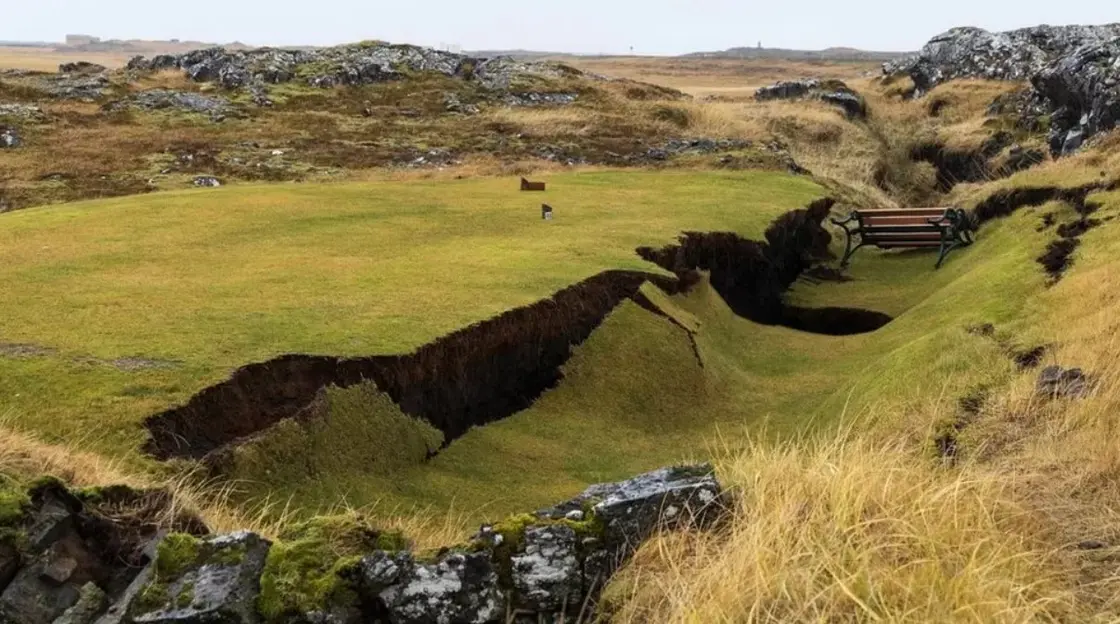Iceland on High Alert: Imminent Volcanic Eruption Threatens Grindavik City with Unprecedented Destruction
Grindavik, a coastal city in Iceland, stands on the brink of a potential catastrophe as volcanic activity intensifies. Authorities have evacuated the city, home to approximately 4,000 residents, amid hundreds of earthquakes triggered by the movement of magma beneath the Earth’s crust. These seismic activities have caused significant ground fissures and cracks in the region.

From a previous volcanic eruption in the Icelandic city of Grindavik - Agence-Source: France-Presse
Vidar Reynisson, head of Iceland’s Civil Protection and Emergency Management, expressed deep concern for all homes and infrastructure in the threatened area. Grindavik, located about 40 kilometers southwest of the capital Reykjavik, is in proximity to the Svartsengi geothermal power station, a critical source of electricity and water for about 30,000 people on the Reykjanes Peninsula. The popular geothermal tourist destination, the Blue Lagoon, also situated nearby, has been temporarily closed as a precautionary measure.
Incredible Drone footage looking down into a volcanic eruption! 🌋 #Iceland #icelandvolcano #Icelandearthquake #IcelandNews #Earthquake #Grindavik #Iceland #earthquakes #eruption #VolcanoEruption #GrindavikTown #Reykjavík #reykjavik #latestnews #BREAKING_NEWS pic.twitter.com/dN4DQdkHou
— Vikas Bailwal (@VikasBailwal4) November 12, 2023
Reynisson warned that the magma is now at an extremely shallow depth, predicting an eruption within hours or at most a few days. The most likely scenario involves a fissure opening near Grindavik. A crack stretching approximately 15 kilometers indicates that an eruption could occur anywhere along this fissure, with a possibility of an underwater eruption, likely leading to a dense ash cloud.
Huge cracks have opened up on the Grindavík golf course in #Iceland due to the many earthquakes they have had….👀
📷 Ragnar Visage pic.twitter.com/2RUK8mwpZH
— Volcaholic 🌋 (@volcaholic1) November 11, 2023
Thousands of earthquakes left a trail of large cracks on roads to the town of Grindavik in Iceland. #iceland #icelandvolcano #Icelandearthquake pic.twitter.com/tF4BD2JWFH
— Nopolluting (@nopolluting) November 12, 2023
Past and Present Volcanic Activity in Iceland
Iceland, with 33 active volcanic systems, declared a state of emergency and ordered the mandatory evacuation of Grindavik early Saturday. Emergency shelters and assistance centers have been established in several neighboring towns. After observing magma accumulation for several days at a depth of about five kilometers underground, the Icelandic Meteorological Office noted that it had begun to rise vertically towards the Earth’s surface. Sara Barsotti, the office’s Volcanic Hazard Coordinator, described the current magma leak as unprecedented in speed, volume, and flow rates compared to previous events in the peninsula.
A New Cycle of Increased Volcanic Activity
Three eruptions near Fagradalsfjall on the Reykjanes Peninsula occurred in March 2021, August 2022, and July 2023. Barsotti noted that the Earth’s crust has fractured severely in the past three years due to these eruptions, allowing molten fluids to escape more rapidly. Volcanologists estimate that this new cycle of increased activity could continue for decades or even centuries.

Iceland, located in the North Atlantic, straddles the Mid-Atlantic Ridge, a rift in the ocean floor separating the Eurasian and North American tectonic plates. In April 2010, the massive eruption of another Icelandic volcano, Eyjafjallajokull, in the south of the island, led to the cancellation of about 100,000 flights, disrupting the travel plans of over 10 million passengers.

